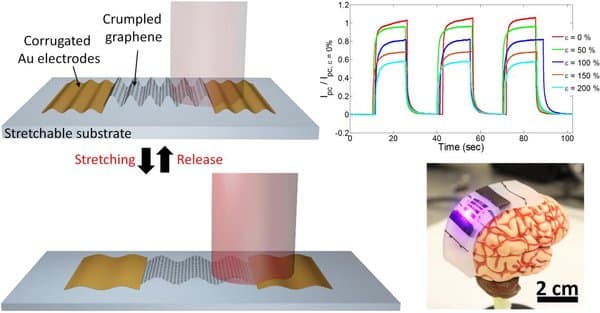Researchers Devise New Method For Manipulating Light Absorption And Stretchability Of 2D Materials
A group of physicists from the University of Illinois at Urbana-Champaign has recently engineered a new approach to customize light absorption and stretchability of atomically thin two-dimensional (2D) materials by measuring the deviation of the surface from a perfectly flat plane. The method takes the help from only the mechanical strain of the material and delivers a desirable output, which when combined with light emitting diodes could produce results capable of significantly boosting wearable technologies and integrated biomedical sensing technology.
SungWoo Nam, assistant professor of mechanical science and engineering at Illinois, explained that their method is based on the honey comb structure of the magic material Graphene, a carbon allotrope with properties such as broadband absorption, high carrier mobility and mechanical flexibility. This material is extensively looked upon as the potential core of the photonics and sensing industry. The team has successfully realised a new concept of a stretchable photo detector which depends on Graphene with its modified characteristics i.e. tunable photoresponsivity and wavelength selectivity.

Stretchable photodetector with strain-tunable photoresponsivity
Although Graphene sports several favorable characteristics, it lacks good optical absorptivity. As a result, until now the systems developed around graphene were mainly hybrid systems. But such systems require complex integration and scales down the carrier mobility considerably. To upgrade the contemporary ones, the scientists shifted from 2D to 3D Graphene by simply increasing the areal density of Graphene. A strain impulse is given from outside, which in turn increased the areal density and helps to respond better in terms of photo-responsivity and stretchability .
Nam also informed that, officially his team was the first to develop a stretchable photodetector with stretching capability of up to 200% of its natural length and this approach is adaptable to other 2D materials as well. The complete research report was published in the Advanced Materials journal.
Source: #-Link-Snipped-#
SungWoo Nam, assistant professor of mechanical science and engineering at Illinois, explained that their method is based on the honey comb structure of the magic material Graphene, a carbon allotrope with properties such as broadband absorption, high carrier mobility and mechanical flexibility. This material is extensively looked upon as the potential core of the photonics and sensing industry. The team has successfully realised a new concept of a stretchable photo detector which depends on Graphene with its modified characteristics i.e. tunable photoresponsivity and wavelength selectivity.

Stretchable photodetector with strain-tunable photoresponsivity
Although Graphene sports several favorable characteristics, it lacks good optical absorptivity. As a result, until now the systems developed around graphene were mainly hybrid systems. But such systems require complex integration and scales down the carrier mobility considerably. To upgrade the contemporary ones, the scientists shifted from 2D to 3D Graphene by simply increasing the areal density of Graphene. A strain impulse is given from outside, which in turn increased the areal density and helps to respond better in terms of photo-responsivity and stretchability .
Nam also informed that, officially his team was the first to develop a stretchable photodetector with stretching capability of up to 200% of its natural length and this approach is adaptable to other 2D materials as well. The complete research report was published in the Advanced Materials journal.
Source: #-Link-Snipped-#
Replies
You are reading an archived discussion.
Related Posts
It’s inevitable that driverless or autonomous cars are our future. From tech giants like Google to car makers like Volvo are involved actively in making prototypes of driverless cars and...
Today's digital world gives ample space to both robots and humans to evolve and move forward with mutual cooperation. Humans can expect robots to aid them in their industry oriented...
hi.. im a civil engineer working on a pvt construction firm, i heard some companies like wipro offering their employees to do higher studies as PG programme related to their...
Have you ever seen the Power Ranger Time Force “A blue streak" episode where driver Lucas Kendall showcased an electronic 3D driver licence which popped up information regarding his expertise?...
I am in final year and I don't get jobs and I don't want to do M. tech . I want to make career in mechanical designing . I have...
